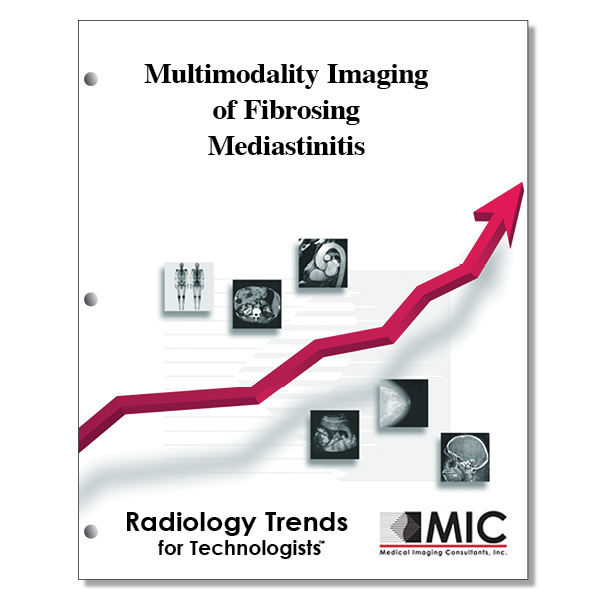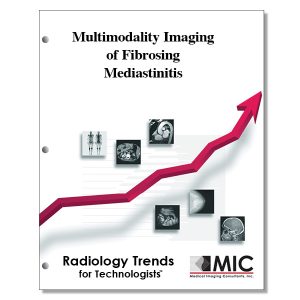

Multimodality Imaging of Fibrosing Mediastinitis
Granulomatous and nongranulomatous fibrosing mediastinitis are presented and imaging findings, prognosis and treatment are reviewed.
Course ID: Q00600 Category: Radiology Trends for Technologists Modalities: CT, Nuclear Medicine, Radiography2.25 |
Satisfaction Guarantee |
$24.00
- Targeted CE
- Outline
- Objectives
Targeted CE per ARRT’s Discipline, Category, and Subcategory classification for enrollments starting after January 27, 2023:
[Note: Discipline-specific Targeted CE credits may be less than the total Category A credits approved for this course.]
Computed Tomography: 2.25
Procedures: 2.25
Neck and Chest: 2.25
Magnetic Resonance Imaging: 1.50
Procedures: 1.50
Body: 1.50
Nuclear Medicine Technology: 0.50
Procedures: 0.50
Endocrine and Oncology Procedures: 0.50
Radiography: 1.50
Procedures: 1.50
Thorax and Abdomen Procedures: 1.50
Registered Radiologist Assistant: 1.75
Procedures: 1.75
Thoracic Section: 1.00
Neurological, Vascular, and Lymphatic Sections: 0.75
Vascular-Interventional Radiography: 1.75
Procedures: 1.75
Vascular Diagnostic Procedures: 1.00
Vascular Interventional Procedures: 0.75
Outline
- Introduction
- Granulomatous FM
- Nongranulomatous FM
- Imaging Modalities and Features of Granulomatous and Nongranulomatous FM
- Spectrum of Imaging Findings and Complications
- Airway Involvement
- Pulmonary Artery and Vein Involvement
- Systemic Vein Involvement
- Pleural Involvement
- Other Complications
- Differential Diagnosis
- Prognosis, Treatment, and Imaging Surveillance
- Conclusion
Objectives
Upon completion of this course, students will:
- recognize the different subtypes of FM
- identify the most common cause of granulomatous FM
- be familiar with the percentage of FM patients with the granulomatous subtype
- be familiar with the regions of the U.S. that are more likely to have a fungus endemic to that area
- be familiar with the percentage of FM patients with the nongranulomatous subtype
- be familiar with the age that patients are most commonly diagnosed with nongranulomatous FM
- be familiar with the immunologic reaction to diseases that lead to nongranulomatous FM
- identify the imaging modalities that are not useful for diagnosing FM
- understand the role that chest radiography plays in diagnosing FM
- identify the imaging modality of choice for diagnosing FM
- be familiar with the areas of the body affected by FM
- understand the potential role of MRI in diagnosing FM
- be familiar with the alternatives for catheter angiography
- be familiar with the role that conventional angiography plays in assessment of FM patients
- be familiar with what creates “golden pneumonia”
- be familiar with mosaic perfusion due to fibrous encasement of the central pulmonary arteries
- be familiar with the useful CT windows employed when imaging FM patients
- be familiar with the use of CT to make an accurate patient diagnosis
- identify the characteristic clinical features of SVC syndrome
- understand the role that nuclear medicine may play in patients with suspected SVC syndrome
- be familiar with the ability for CT to assist in patient diagnosis
- be familiar with the cause of chylothorax
- be familiar with the effects of fibrosis on the esophagus
- be familiar with the criteria for diagnosis for granulomatous FM
- recognize the significance of granulomatous calcifications in FM patients
- be familiar with the information that may be necessary for diagnosing nongranulomatous FM
- be familiar with the imaging modality appropriate for tissue sampling
- be familiar with the known patient complications of FM
- recognize the uncommon complications related to vascular stent placement
- be familiar with medical interventions in FM patients with airway compromise
- recognize the surgical interventions that may be necessary in FM patients
- be familiar with the diagnostic ability of CT to differentiate disease in FM patients
- be familiar with the serious outcomes resulting from FM
- be familiar with the tools used to monitor patients suffering with FM
- be familiar with new therapeutics to treat patients with FM
